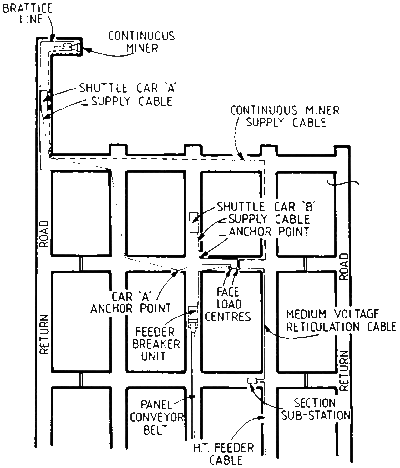SHUTTLE CAR
Equipment 0 Commentout 150 m. By back spooling of cables from an intermediate cable anchorage point the operational reach can be doubled but this may result in reduced cable life and is usually used only for specialised drivages.
To avoid cable tangling as the cars are usually used in pairs with a continuous miner, one car has its cable reel on the left side, the other on the right side. A typical cable layout is as shown on the right.
Wherever practicable the cars are arranged to have different wheeling paths around pillars as this minimises wheeling and shunting delays and reduces cable damage, however in concentrated workings this is not always possible. Where several paths are available then more than two shuttle cars can be used as in South African (RSA) practice where up to six may be used to improve production rates but this is practicable only where the panel is a traditional bord and pillar layout with small pillars and many headings. Such practice is not common in Australia.
Clearly the problems of cable paths and cable damage suggest that independent self-powered cars would be attractive but although several diesel and diesel hydraulic shuttle car types have been used they have not found general acceptance as viable replacements for the electric trailing cable powered cars, largely due to their higher maintenance requirements and increased downtime.
Equally clearly the discontinuous operation of continuous miners is as much due to the batch conveying by shuttle cars as it is to roof support delays. An alternative is continuous conveying.


SPECIFICATIONS OF SHUTTLE CARS AND LONG AIRDOX UN-A-HAULER
| Manufacturer & type |
Dimensions (m) |
Grouund Clearance | Machine weight (empty) |
Machine Capacity (m3) | Cable Reel Length | Maximum rated capacity | Tram Speed m/s |
Conveyor Speed | Motors | ||||
| L | W | H | (m) | (t) | Without Sideboard | With Sideboard | m | t | Empty | Loaded | m/s | ||
| Joy 10 SC22 40/48/56/64*A |
8.16 | 2.44- 3.05 |
1.02 | 0.25 | 13.8-14.50 | 4.0-6.0 | 5.5-8.0 | 128-129 | 12.24 | 2.24 | 2.01 | 0.5 | Two @ 15-23KW (DC) Two @ 30 KW (AC) |
| Joy 10 SC22 40/48/56/64*B |
8.16 | 2.44- 3.05 |
1.27 | 0.25 | 14.50-15.20 | 6.5-9.5 | 8.2-11.6 | 155-256 | 12.24 | 2.24 | 2.01 | 0.5 | Two @ 15-22 KW (DC) Two @ 30-37 KW (AC) |
| Joy 10 SC22 40/48/56/64*C |
8.16 | 2.44- 3.05 |
1.33 | 0.32 | 15 – 15.66 | 6.5-9.5 | 8.2-11.6 | 155-256 | 12.24 | 2.24 | 2.01 | 0.5 | Two @ 22-26 KW (DC) Two @ 30 – 37 KW (AC) |
| Noyes Bros – NSC 1250E |
8.4 | 2.8 | 1.25 | 0.25 | – | 10.88 | 14.58 | – | – | 0 – 2.0 | – | 0.43 | Two @ 30 KW (AC) |
| Noyes Bros – NSC 1500E |
8.4 | 2.8 | 1.50 | 0.30 | – | 13.96 | 16.38 | – | – | 0 -1.88 | – | – | Two @ 30 KW (AC) |
| Noyes Bros – Hydrocar** 10/50 |
8.08 | 2.77 | 1.27 | 0.25 | – | – | – | – | – | – | – | – | One @ 74.6 KW (AC) |
| Fox National 48B-*43/49/55-48 | 8.3 | 2.64- 2.95 |
1.22 | 0.25 | 14.35 | 6.4-7.8 | 8.1-9.9 | – | – | 0- 2.0 | 2.0 | 0.42-0.63 | One @ 56 AC One @ 30AC One @ 12AC |
| Jeffrey Dresser 4015 | 8.31 | 2.92 | 1.42 | 0.356 | 18.14 | 10.76 | 12.60 | – | 6 – 16.3 | 0 – 2.03 | – | – | Two @ 45KW(AC) |
| Long Airdox Un-A-Hauler |
10.8 | 3.2 | 1.83 | 0.375 | 28.53*** | 16.3 | – | – | – | 0 – 1.95 | – | ||
* Relates to the respective conveyor width and the machine.
**The method and traction is by hydraulic transmission for improved operative control during tramming. In the case of electric shuttle cars, the tramming motors give better low speed control; however, it requires a high degree of maintenance supervision
*** Weight includes battery weight.
